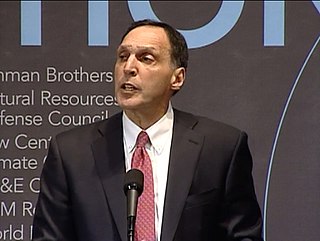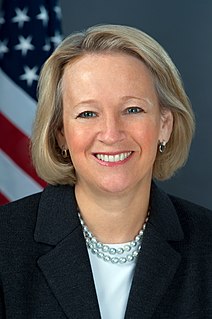Related Research Articles

The U.S. Securities and Exchange Commission (SEC) is an independent agency of the United States federal government, created in the aftermath of the Wall Street Crash of 1929. The primary purpose of the SEC is to enforce the law against market manipulation.

Morgan Stanley is an American multinational investment bank and financial services company headquartered at 1585 Broadway in Midtown Manhattan, New York City. With offices in more than 42 countries and more than 60,000 employees, the firm's clients include corporations, governments, institutions, and individuals. Morgan Stanley ranked No. 67 in the 2018 Fortune 500 list of the largest United States corporations by total revenue.

Banking in the United States began by the 1780s along with the country's founding and has developed into highly influential and complex system of banking and financial services. Anchored by New York City and Wall Street, it is centered on various financial services namely private banking, asset management, and deposit security.

Citigroup Inc. or Citi is an American multinational investment bank and financial services corporation headquartered in New York City. The company was formed by the merger of banking giant Citicorp and financial conglomerate Travelers Group in 1998; Travelers was subsequently spun off from the company in 2002. Citigroup owns Citicorp, the holding company for Citibank, as well as several international subsidiaries. Citigroup is incorporated in Delaware.
The Municipal Securities Rulemaking Board (MSRB) writes investor protection rules and other rules regulating broker-dealers and banks in the United States municipal securities market, including tax-exempt and taxable municipal bonds, municipal notes, and other securities issued by states, cities, and counties or their agencies to help finance public projects or for other public policy purposes.

A collateralized debt obligation (CDO) is a type of structured asset-backed security (ABS). Originally developed as instruments for the corporate debt markets, after 2002 CDOs became vehicles for refinancing mortgage-backed securities (MBS). Like other private label securities backed by assets, a CDO can be thought of as a promise to pay investors in a prescribed sequence, based on the cash flow the CDO collects from the pool of bonds or other assets it owns. Distinctively, CDO credit risk is typically assessed based on a probability of default (PD) derived from ratings on those bonds or assets.
Moody's Investors Service, often referred to as Moody's, is the bond credit rating business of Moody's Corporation, representing the company's traditional line of business and its historical name. Moody's Investors Service provides international financial research on bonds issued by commercial and government entities. Moody's, along with Standard & Poor's and Fitch Group, is considered one of the Big Three credit rating agencies. It is also included in the Fortune 500 list of 2021.
Raymond James Financial is an American multinational independent investment bank and financial services company providing financial services to individuals, corporations, and municipalities through its subsidiary companies that engage primarily in investment and financial planning, in addition to investment banking and asset management. Raymond James Financial is one of the largest banking institutions in the United States The corporate headquarters is located in St. Petersburg, Florida.

Richard Severin Fuld Jr. is an American banker best known as the final chairman and chief executive officer of investment bank Lehman Brothers. Fuld held this position from the firm's 1994 spinoff from American Express until 2008. Lehman Brothers filed for bankruptcy protection under Chapter 11 on September 15, 2008, and subsequently announced the sale of major operations to parties including Barclays Bank and Nomura Securities.

An auction rate security (ARS) typically refers to a debt instrument with a long-term nominal maturity for which the interest rate is regularly reset through a dutch auction. Since February 2008, most such auctions have failed, and the auction market has been largely frozen. In late 2008, investment banks that had marketed and distributed auction rate securities agreed to repurchase most of them at par.
The United States subprime mortgage crisis was a multinational financial crisis that occurred between 2007 and 2010 that contributed to the 2007–2008 global financial crisis. It was triggered by a large decline in US home prices after the collapse of a housing bubble, leading to mortgage delinquencies, foreclosures, and the devaluation of housing-related securities. Declines in residential investment preceded the Great Recession and were followed by reductions in household spending and then business investment. Spending reductions were more significant in areas with a combination of high household debt and larger housing price declines.
The Financial Industry Regulatory Authority (FINRA) is a private American corporation that acts as a self-regulatory organization (SRO) that regulates member brokerage firms and exchange markets. FINRA is the successor to the National Association of Securities Dealers, Inc. (NASD) as well as the member regulation, enforcement, and arbitration operations of the New York Stock Exchange. The US government agency that acts as the ultimate regulator of the US securities industry, including FINRA, is the US Securities and Exchange Commission (SEC).
The subprime mortgage crisis impact timeline lists dates relevant to the creation of a United States housing bubble and the 2005 housing bubble burst and the subprime mortgage crisis which developed during 2007 and 2008. It includes United States enactment of government laws and regulations, as well as public and private actions which affected the housing industry and related banking and investment activity. It also notes details of important incidents in the United States, such as bankruptcies and takeovers, and information and statistics about relevant trends. For more information on reverberations of this crisis throughout the global financial system see Financial crisis of 2007–2008.
This article provides background information regarding the subprime mortgage crisis. It discusses subprime lending, foreclosures, risk types, and mechanisms through which various entities involved were affected by the crisis.
The Emergency Economic Stabilization Act of 2008, often called the "bank bailout of 2008", was proposed by Treasury Secretary Henry Paulson, passed by the 110th United States Congress, and signed into law by President George W. Bush. The act became law as part of Public Law 110-343 on October 3, 2008, in the midst of the financial crisis of 2007–2008. The law created the $700 billion Troubled Asset Relief Program (TARP) to purchase toxic assets from banks. The funds for purchase of distressed assets were mostly redirected to inject capital into banks and other financial institutions while the Treasury continued to examine the usefulness of targeted asset purchases.

Mary Lovelace Schapiro served as the 29th Chair of the U.S. Securities and Exchange Commission (SEC). She was appointed by President Barack Obama, unanimously confirmed by the U.S. Senate, and assumed the Chairship on January 27, 2009. She is the first woman to be the permanent Chair of the SEC. In 2009, Forbes ranked her the 56th most powerful woman in the world.
The Subprime mortgage crisis solutions debate discusses various actions and proposals by economists, government officials, journalists, and business leaders to address the subprime mortgage crisis and broader financial crisis of 2007–08.
Many factors directly and indirectly serve as the causes of the Great Recession that started in 2008 with the US subprime mortgage crisis. The major causes of the initial subprime mortgage crisis and the following recession include lax lending standards contributing to the real-estate bubbles that have since burst; U.S. government housing policies; and limited regulation of non-depository financial institutions. Once the recession began, various responses were attempted with different degrees of success. These included fiscal policies of governments; monetary policies of central banks; measures designed to help indebted consumers refinance their mortgage debt; and inconsistent approaches used by nations to bail out troubled banking industries and private bondholders, assuming private debt burdens or socializing losses.

The financial crisis of 2008, or Global Financial Crisis (GFC), was a severe worldwide economic crisis that occurred in the late 2000s. It was the most serious financial crisis since the Great Depression (1929). Predatory lending targeting low-income homebuyers, excessive risk-taking by global financial institutions, and the bursting of the United States housing bubble culminated in a "perfect storm." Mortgage-backed securities (MBS) tied to American real estate, as well as a vast web of derivatives linked to those MBS, collapsed in value. Financial institutions worldwide suffered severe damage, reaching a climax with the bankruptcy of Lehman Brothers on September 15, 2008, and a subsequent international banking crisis.
Wall Street and the Financial Crisis: Anatomy of a Financial Collapse is a report on the financial crisis of 2007–2008 issued on April 13, 2011 by the United States Senate Permanent Subcommittee on Investigations. The 639-page report was issued under the chairmanship of Senators Carl Levin and Tom Coburn, and is colloquially known as the Levin-Coburn Report. After conducting "over 150 interviews and depositions, consulting with dozens of government, academic, and private sector experts" found that "the crisis was not a natural disaster, but the result of high risk, complex financial products, undisclosed conflicts of interest; and the failure of regulators, the credit rating agencies, and the market itself to rein in the excesses of Wall Street." In an interview, Senator Levin noted that "The overwhelming evidence is that those institutions deceived their clients and deceived the public, and they were aided and abetted by deferential regulators and credit ratings agencies who had conflicts of interest." By the end of their two-year investigation, the staff amassed 56 million pages of memos, documents, prospectuses and e-mails. The report, which contains 2,800 footnotes and references thousands of internal documents focused on four major areas of concern regarding the failure of the financial system: high risk mortgage lending, failure of regulators to stop such practices, inflated credit ratings, and abuses of the system by investment banks. The Report also issued several recommendations for future action regarding each of these categories.
References
- 1 2 Danny Schechter (2010). The Crime of Our Time: Why Wall Street Is Not Too Big to Jail. ISBN 978-1-934708-55-2 . Retrieved June 16, 2011.
- 1 2 Phil Trupp (2010). Ruthless: How Enraged Investors Reclaimed Their Investments and Beat Wall Street . John Wiley and Sons. ISBN 978-0-470-57989-3 . Retrieved June 16, 2011.
sense on cents.
- ↑ Doyle, Larry (June 2010). "Put Europe's Banks to the Test". Business Week. Retrieved June 16, 2011.
- 1 2 Beck, Rachel (January 5, 2010). "Under Obama's new plan: No consequences for lying borrowers". Pottstown Mercury. Retrieved June 16, 2011.
- ↑ Preston, Darrell (April 29, 2009). "Finra Oversees Auction-Rate Arbitrations After Exit". Bloomberg. Retrieved June 16, 2011.
- ↑ "About". Sense on Cents. Retrieved June 17, 2011.
- ↑ Joseph A. Giannone (April 7, 2010). "FINRA faces calls to lift veil on finances, pay". Fox Business. Retrieved June 16, 2011.
- ↑ http://www.senseoncents.com/in-bed-with-wall-street/
- ↑ Larry Doyle (June 8, 2011). "New banking rules have not hurt Jamie Dimon - Term Sheet". Fortune.cnn.com. Retrieved June 16, 2011.
- ↑ Richard Lee (August 2, 2010). "Business People: Kramer joins ENT and Allergy Associates". Connecticut Post. Retrieved June 16, 2011.